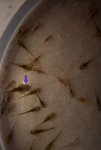Almost 2 years ago now, I decided to get myself a pair of axolotls. I now own 2 very healthy adults, 1 wild type male and 1 leucistic female. To my amazement last December they laid their first clutch (do you call them clutches?) of eggs! Me and my friend were so surprised and we immediately started collecting the eggs and setting up another tank to raise the young. A month later, after successfully hatching the 1st clutch, they laid another, more numerous bunch! I have had some casualties, which is expected in every batch of eggs, but the healthy ones are feeding voraciously on the live brine shrimp I hatch for them and are doing great! But I have some questions to ask:
1) I am keeping babies from 2 seperate clutches of eggs together in a 18 gallon tank with no substrate, a live plant and an air stone. There is only a month difference in between. Is there a risk of the older axolotls outgrowing and cannibalising their younger siblings? I have monitored them and seen no signs of misbehaviour so far, but would like to take precautions.
2) I intend to sell the young and know many people interested in buying them from me. I took the responsibility of writing a care sheet in my own words to hand out to all my customers. If an expert could take a look at it to see if it requires any corrections I would be eternally greatful.
3) Many of the people interested in buying my axolotls ask me if they can have a pair of 1 leucistic and 1 wild type but unfortunately I do not know how to answer them because of 2 reasons:
A) They are still so young they are basically transparent. I cannot differentiate between the colour morphs at their current age.
B) I am finding it difficult to understand the genetics of these animals. What are the possible outcomes of the offspring if i have a leucistic female and a wild type male.
Attached please find a photo of my 2 adults, a photo for size comparison of the young and my care sheet. I realise there is some dirt on the bottom of their tank, it is a combination of uneaten brine shrimp, waste and some sand particles from the adult tank which got transfered along with the eggs. I keep it very clean with water changes so please do not judge.
Thanks in advance!
Kevin
1) I am keeping babies from 2 seperate clutches of eggs together in a 18 gallon tank with no substrate, a live plant and an air stone. There is only a month difference in between. Is there a risk of the older axolotls outgrowing and cannibalising their younger siblings? I have monitored them and seen no signs of misbehaviour so far, but would like to take precautions.
2) I intend to sell the young and know many people interested in buying them from me. I took the responsibility of writing a care sheet in my own words to hand out to all my customers. If an expert could take a look at it to see if it requires any corrections I would be eternally greatful.
3) Many of the people interested in buying my axolotls ask me if they can have a pair of 1 leucistic and 1 wild type but unfortunately I do not know how to answer them because of 2 reasons:
A) They are still so young they are basically transparent. I cannot differentiate between the colour morphs at their current age.
B) I am finding it difficult to understand the genetics of these animals. What are the possible outcomes of the offspring if i have a leucistic female and a wild type male.
Attached please find a photo of my 2 adults, a photo for size comparison of the young and my care sheet. I realise there is some dirt on the bottom of their tank, it is a combination of uneaten brine shrimp, waste and some sand particles from the adult tank which got transfered along with the eggs. I keep it very clean with water changes so please do not judge.
Thanks in advance!
Kevin




